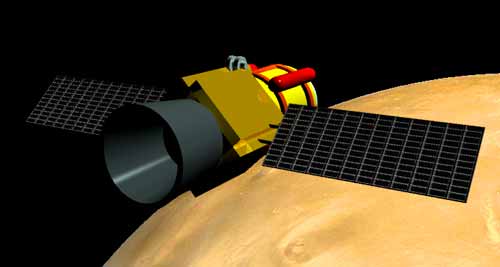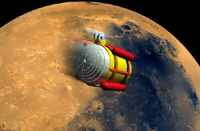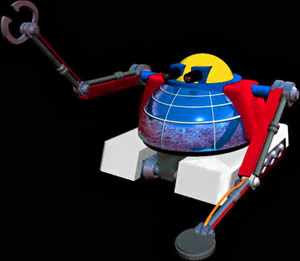|
Transit to Mars
The Transit Vehicle
Once into orbit around the Earth our spacecraft will look like this (above). From here we can fire the transit engine, which will blast the spacecraft out of Earth orbit and place it on a curved path or trajectory, to Mars. The transit engine does not have to work all the way. In fact it only works for a few minutes, just enough to change the direction and speed so that the spacecraft can coast to Mars. Once there it will turn itself around using tiny thruster rocket motors, and then fire the main engine to slow down. It can then go into orbit around the planet.
Our transit vehicle consists of three separate units.

Orbiter
This remains in space, orbiting the planet. It collects images of the surface, detects the magnetic field of the planet and examines the atmosphere from above. It uses a variety of instruments which detect light, magnetism, infra-red and ultra-violet radiation. These data can be analysed by scientists and from it they can tell a lot about the planet and its environment. Our orbiter has a main body, which contains the electronic equipment for the instruments and communications with Earth; solar panels, which turn sunlight into energy to power the spaccraft; dish antennae for communication with Earth and the Lander; a main rocket motor (transit engine), to send it off towards Mars.
Attached to one end is the Lander pod, which contains MARTI.

Lander
The lander for our mission is like a sausage. It contains our robot Rover MARTI. It also carries science instruments and a communication system, so we on Earth can control it and get back data.

Remember our Mission Objectives? We need instruments to achieve these:
We have:
- Three cameras systems for taking pictures of the landscape, on the orbiter, the rover and the lander
- A nutrient experiment to look for life, on the rover
- A weather station to watch the weather, on the lander
- Several spectrometers to find out what Mars is made of, on the orbiter, the rover and lander
- A magnetometer to investigate Mars' magnetic field, on the orbiter
- A seismometer to check for earthquakes, on the lander
- Radiation detectors to observe the levels of light and radiation, on the orbiter and lander
Once the transit spacecraft is in orbit around Mars at a height of perhaps 200 or 300 kilometres (125 -175 miles) the lander section will separate from the orbiter. It will be travelling at high speed - about 18,000 kilometres per hour (11,250 mph) - but will have to land safely. To do this it first fires some rockets in the opposite direction to that it is travelling in. These are called retro-rockets. By slowing down, the lander plunges down towards the planet. As it enters the atmosphere it is slowed some more, but it heats up. Eventually the lander is going so slow it can use a parachute, or perhaps as many as three parachutes. This slows the descent to a gentle one. When the lander is about 1000 metres above the ground sausage shaped balloons along the side, inflate. These absorb the shock of touch-down.
We don't exactly know the place we shall touch down. It may be rocky or flat, full of pot-holes or hilly. We need to have prepared our lander for any eventuality. The lander, being a sausage shape will always - unless it is extremely unlucky - land length-ways. Have you ever tried to stand a sausage on its end?
Once lying down we can unpack the lander. But what if it is upside-down?
Well the lander is a cylinder. If we make another cylinder inside the first, we can turn one relative to the other. Our lander is made so that the contents - MARTI and the instruments - are fixed to an internal cylinder. Which ever way the lander touches down, the inside can turn until it the right way up.
The ends of our sausage are dome shaped doors which open so MARTI can get out. The doors are also communication antennae. We have two doors and two antennae in case one end is trapped on landing.
The instruments are all held in a single pack. This is on a rail that runs inside the top of the cylinder. The rail is telescopic and extends out the ends of the lander once the doors are open. The instruments are then deployed outside on the rail. They too then deploy from their packed position.
Power to the lander comes from solar panels which deploy on the rail.

Project:
Task 1: To see how it works, get a couple of cardboard tubes from wrapping paper or kitchen roll. Put one in the other. If they are a good fit one will turn inside the other.
Task 2: Devise and build an instrument to show which way is up, from scrap materials.
Task 3: Can you determine what other methods of ensuring a spacecaft is safe after touch-down is used? (Hint: Try an internet search)

Rover

MARTI - the Mars Autonomous Robotic Terrain Investigator - is the rover. His task is to explore the area around the landing site. He is fitted with tracks, a camera system and two arms. One arm is a manipulator to pick things up, while the other holds a sensor head. This consists of spectrometers and the life nutrient experiment. He is battery-, or rather fuel cell-, powered and his main body is covered with solar cells to charge him up.
Go here for more on Robot Rovers.

For more information on Mars spacecraft, landers and rovers check out these web sites.
Mars Global Surveyor
Mars Pathfinder
Surveyor 98
Surveyor 2001
Beagle 2
Return to Journey
|













